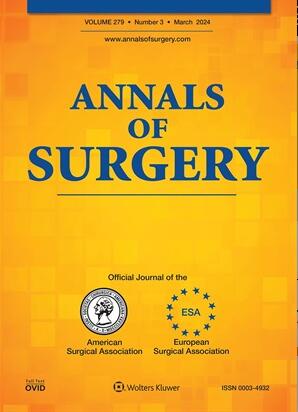胸突手术期间肋间神经冷冻消融治疗术后疼痛:系统回顾和荟萃分析。
IF 6.4
1区 医学
Q1 SURGERY
引用次数: 0
摘要
本研究的目的是系统地回顾文献报道的PEx修复后冷冻与标准护理不冷冻(非冷冻)的结果。背景:通过Nuss或Ravitch手术修复漏斗胸(PEx)与严重的术后疼痛相关。肋间神经冷冻消融术(CRYO)在初级手术修复期间已被作为一种非阿片类药物治疗疼痛的方式。方法在PubMed、Embase和其他在线方法中进行文献检索,以确定2014-24年间接受Nuss或Ravitch手术进行冷冻与非冷冻PEx修复的患者的比较研究。采用荟萃分析定量评价住院时间(LOS)和阿片类药物消耗的主要结局。次要结局是医院费用和并发症,定性总结。结果178项研究中,32项比较研究包括13103例患者;28% (n=3,620)接受CRYO治疗。随机效应荟萃分析显示,患者LOS显著缩短了1.8天(95%可信区间[CI]: -2.12, -1.42), CRYO患者住院和门诊阿片类药物消耗分别显著减少186吗啡毫克当量(MME) (95% CI: -262.26, -109.08)和147吗啡毫克当量(95% CI: -255.72, -38.26)。CRYO的并发症在两组之间减少或相似,并随着时间的推移而消失。住院费用也差不多。结论:本系统综述表明,PEx修复期间的低温与较短的住院LOS以及院内和出院后阿片类药物消耗减少有关。并发症不常见且时间有限。本文章由计算机程序翻译,如有差异,请以英文原文为准。
Intercostal Nerve Cryoablation During Pectus Excavatum Surgery for Postoperative Pain Management: A Systematic Review and Meta-Analysis.
OBJECTIVE
The objective of this study was to systematically review the literature-reported outcomes of CRYO compared to standard of care without CRYO (non-CRYO) after PEx repair.
SUMMARY BACKGROUND DATA
Surgical repair of pectus excavatum (PEx) via the Nuss or Ravitch procedures is associated with substantial postoperative pain. Intercostal nerve cryoablation (CRYO) performed during the primary surgical repair has been adopted as a non-opioid modality for pain management.
METHODS
A literature search was conducted in PubMed, Embase, and using additional online approaches to identify comparative studies of patients undergoing the Nuss or Ravitch procedure for PEx repair with CRYO versus non-CRYO between years 2014-24. Meta-analysis was performed to quantitatively evaluate primary outcomes of hospital length of stay (LOS) and opioid consumption. Secondary outcomes were hospital costs and complications, summarized qualitatively.
RESULTS
Of 178 studies, 32 comparative studies encompassing 13,103 patients were included; 28% (n=3,620) received CRYO. Random effects meta-analyses demonstrated a significantly shortened LOS by 1.8 days (95% confidence interval [CI]: -2.12, -1.42) and a significant reduction in inpatient and outpatient opioid consumption with CRYO by 186 morphine mg equivalents (MME) (95% CI: -262.26, -109.08) and 147 MME (95% CI: -255.72, -38.26), respectively. Complications with CRYO were either decreased or similar between groups and resolved over time. Hospital costs were similar.
CONCLUSIONS
This systematic review suggests CRYO during PEx repair is associated with a significantly shorter hospital LOS, as well as decreased opioid consumption both in the hospital and after discharge. Complications were infrequent and time-limited.
求助全文
通过发布文献求助,成功后即可免费获取论文全文。
去求助
来源期刊

Annals of surgery
医学-外科
CiteScore
14.40
自引率
4.40%
发文量
687
审稿时长
4 months
期刊介绍:
The Annals of Surgery is a renowned surgery journal, recognized globally for its extensive scholarly references. It serves as a valuable resource for the international medical community by disseminating knowledge regarding important developments in surgical science and practice. Surgeons regularly turn to the Annals of Surgery to stay updated on innovative practices and techniques. The journal also offers special editorial features such as "Advances in Surgical Technique," offering timely coverage of ongoing clinical issues. Additionally, the journal publishes monthly review articles that address the latest concerns in surgical practice.
 求助内容:
求助内容: 应助结果提醒方式:
应助结果提醒方式:


